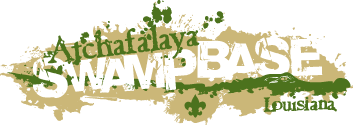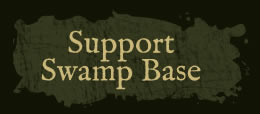Trek 2 FAQ's
1. Is Trek 1 a prerequisite for Trek 2 participation?
It sure isn’t! Trek 2 is a completely different form of high adventure. Though both include plenty of paddling, Trek 2 involves a lot more primitive camping.
2. Is Trek 2 more difficult than Trek 1?
In sort yes. Trek 2’s trail is approx. 13 miles longer than Trek 1’s, and does not include a layover day. In addition, each night on Trek 2 requires participants to set up primitive campsites and sleep in jungle hammocks, much more exposed to the elements of the swamp.
3. What time do we need to arrive to the University of Louisiana at Lafayette on our Arrival Day?
Trek Crews need to arrive at University of Louisiana at Lafayette at 2:00 pm to begin their orientation. Your Trek Guide will be there to greet you and accompany you through the Arrival Day process.
4. What are the Trek 1 start dates?
Two treks start daily from June 6th to July 7th.
5. What does our Trek crew # mean?
The first six numbers of your trek crew number is the date that your crew is supposed to arrive in Lafayette for your trek. It is a YYMMDD dating format. Following the date is “02,” representing Trek 2, the program you’re participating on, and then “A .” Lastly, the “ST” stands for Swamp Trek.
6. What day are we supposed to arrive?
Please reference your trek crew number. The date of your arrival is the first six digits of your trek crew number, YYMMDD. Please arrive at the University of Louisiana at 2:00 pm on this date.
7. When does the Swamp Base program officially end?
The program officially ends after dinner after returning to Lafayette. This is approximately 7:30 pm.
8. What time are we allowed to checkout on our final day?
The university requests that all crews checkout of the dorms and return their keys no later than 9:00 am. Nothing is required in the checkout procedure except returning the keys to the drop box. Please note that crews are allowed to depart earlier if they so choose.
9. Do the crews receive their BSA Health Forms at the conclusion of their trek?
No. Due to HIPAA laws, Swamp Base destroys all medical forms at the completion of the crew’s trek. Swamp Base requires that all crews provide copies of the original health forms.
10. How many portages are there and what are their lengths?
There are two portages on Trek 2. What Day 2 lacks in distance, in makes up for with two major variables... the Sandlot Portage and the daunting Green Mile Portage.
The difficulty of the portages is dependent on the amount of water in the swamp. When water levels are high, the land disappears and the portages can be easily paddled or floated. However, when the water is low, the portages grow in distance quite rapidly, with the Green Mile Portage stretching to 2,500 feet of muddy trail! There's a reason that the halfway mark of the Green Mile Portage has been nicknamed "Tapout Point."
Note: The Green Mile Portage can be excessively muddy and difficult. Boots are required to complete this portage, as regular shoes will not stay on. Physical conditioning prior to arriving is highly recommended.
11. Do the canoes provided have backrests?
They do not. If you require a backrest for your trek, please consider bringing one with you.
12. What are kayak paddles used with the canoes versus traditional canoe paddles?
Many people don’t realize how comfortable and efficient it is to use a kayak paddle with a canoe. When using a kayak paddle there are no wet laps from switching sides or having to use a J-stroke, it’s easier to turn the boat, correct your direction, stop, and accelerate. It also allows for inexperienced paddles to gain confidence and paddle more efficiently.
We won’t prevent you from bringing your own canoe paddle, but we think you will see how enjoyable it is to paddle a canoe with a kayak paddle.
13. Can I bring my own kayak, canoe, paddle, or PFD?
Swamp Base only allows for participants to furnish their own paddle if they see it as necessary. The paddling gear used on our high adventure treks is top of the line equipment, and due to space and liability reasons, we cannot allow individuals to bring their own boats or personal floatation devices.
14. Do the university dorm rooms include linens, pillows, toiletries and towels?
No they do not. If you require a larger pillow or more sheets for your two nights in the dorm, please plan to bring them with you and then store them in your vehicle while on the trek. Don’t forget plenty of bath soap for after the trek!
15. Why do we need to bring four separate water bottles versus one gallon jug?
We recommend multiple water bottles so that in case of a capsized canoe or spillage, that not all of the water is lost. This method ensures that everyone always has a container to hold water. Additionally, it is less cumbersome to carry one 32oz. bottle around our program areas, then to have to drag a gallon container.
16. Why do we need to bring two 20L dry bags?
Dry bags are the preferred method of carrying gear in the swamp, because they keep personal gear dry. Please do not bring backpacks or duffel bags in the swamp. We recommend using two dry bags versus one larger bag for a couple reasons: 1) Having two bags provides for better organization of gear while on the water. One bag can serve as the overnight container and the other for paddling. Additionally, it makes getting to items much easier without having to unpack and repack dry bags at every need. 2) In the event that a canoe capsizes and a bag is not properly secured, only half of the person's items will be lost or wet, as opposed to all of their items.
17. How dangerous are alligators?
Most alligators, if left alone, will move on. Alligators less than 4 feet in length are naturally fearful of humans and are generally not a threat to pets, livestock, or humans.
Although alligator attacks in Louisiana are extremely rare, it can happen. The "attack" reports in Louisiana are usually more accurately described as "encounters." As with all outdoor activities, realize that wildlife encounters are a possibility (please see “Tips for Recreating in Alligator Habitats”).
18. How bad are the mosquitoes deep in the swamp on Trek 2?
Not bad at all. Mosquitoes are part of the environment, but they aren’t going to fly you away or suck all your blood. Wearing a Swamp Base Trek shirt and proper bug repellant will do the trick, and make them no more than a nuisance from time to time.
19. Do participants paddle with food?
Yes. 13 of the 16 included meals are to be carried on the trek. Crews are encouraged to bring their own “Snack Packs” if they have above average appetites. Swamp Base provides food for “normal consumption” while paddling (see “Paddling Gear”).
20. What do I do if I need to use the bathroom while on the trail?
If no land is around, you jump in the water of course! Your trek guide will teach you the proper way of relieving yourself in the swamp.
21. Why is it required to have laced hard soled shoes as part of our gear?
Stepping on something sharp while on the trail can be a deal breaker, and the participant could be removed for good from their trek. Additionally, the Green Mile Portage and campsites can be incredibly muddy during summertime storms. Making sure your shoes stay on is a must.
22. Does Swamp Base provide water filters, and if so, what kinds of water filter is used?
Yes, Swamp Base provides water filtration for all treks. This is so that we make sure that the systems being used are sanitary and functional for the environment. Sawyer filters are used throughout the trek. These filters remove 99.99999% of all bacteria, such as salmonella, cholera and E.coli; removes 99.9999% of all protozoa, such as giardia and cryptosporidium.
23. What kind of hammocks are provided by Swamp Base?
We use Hennessy Explorer Deluxe Asym Zip. These hammocks include rainflies, bug netting, and are designed to hold people up to 300lbs. and 7’ tall.
24. What happens if I forgot something I need for the trek?
Not to worry! The Evangeline Area Council, BSA has a Scout Shop that sells most of what crews will need on the trek. There is also an Academy Sports + Outdoor store and Walmart in the area.
25. Approximately how many paddle strokes will it take to complete the trek?
We have estimated the amount of paddle strokes to be around 38,000.
26. What is the payment schedule and when is the Final Roster due?
The 1st Payment is due on October 3, 2018. This payment is $2,500 per trek crew and is non-refundable.
The Final Payment and $500 Damage Deposit is due on March 1, 2019. The remaining balance and final roster is due on this day. The balance paid is non-refundable. Note: The Final Roster will determine the remaining balance owed.
27. What certifications are required?
All registered adults must arrive providing proof that they have completed the BSA Youth Protection Training or Venturing Youth Protection Training. At least adult leader must be trained in First Aid and CPR from any recognized agency and also in Safe Swim Defense, Safety Afloat, and Weather Hazards.
28. Can we take our Swim Test at Swamp Base?
Unfortunately no. BSA Swim Tests must be completed prior to arriving at Swamp Base and signed off by a certified lifeguard. A copy of the lifeguard’s certification is required to complete the Swim Test certificate.
29. Can I use my CPAP machine on Trek 2?
No electricity is available on the trek. The only nights with electricity are the Arrival and Departure nights at the university.
30. How hot is it in the summer in South Louisiana?
“Il fait chaud!” (It is hot!) June/July high temperatures average in the low 90s Fahrenheit with average humidity levels at 78% (see “General Climate Conditions”).
31. What dod I do with my dorm room key?
PLEASE RETURN THE DORM ROOM KEY TO THE DROP BOX AT THE FRONT DESK OF THE DORM. The price of a lost/unreturned key is $200 (This is the amount that the university charges for all lost dorm room keys, as several locks have to be replaced when a key is lost or unreturned).
32. What do crews flying to Swamp Base do with their luggage?
For flying crews’, Swamp Base provides storage for your luggage while you’re in the swamp. Please take out all trek related gear from the suitcases, and load both your trek gear and your empty luggage on to the Swamp Base trailer in the morning when the crew departs for the trailhead. Please don't leave anything at the university. When the trailer returns to Lafayette after dropping the crew off, we will unload the luggage and place your gear in our locked building. When the crew passes by the Swamp Base office at the conclusion of the trek, we will return the empty luggage to you.
33. When can we buy Swamp Base merchandise?
Swamp Base merchandise can be purchased at the end of the trek on Day 5, prior to returning to the university. Please bring your money with you on the water so that you have funds available when you get to the Evangeline Area Council’s Scout Shop. Swamp Base offers Nalgene® bottles, shirts, stickers, belts and buckles, snacks, and many other cool items! Gear can also be purchased at www.swampbaseoutfitters.org.
34. Can I or should I bring my smartphone on the trek?
Yes, it is encouraged to bring your smartphone on the trek to document your experience through Facebook, Twitter, or Instagram. However, there is no opportunity for recharging in the swamp.
When uploading images, please use #swampbase for all posted photos/videos from the trek. Please note that Swamp Base may “share” these photos or videos on its Facebook, Twitter, or Instagram accounts. It is also possible that at the end of the summer, Swamp Base may use these photos for future high adventure marketing videos or brochures.


















